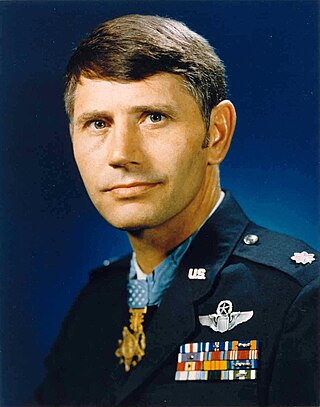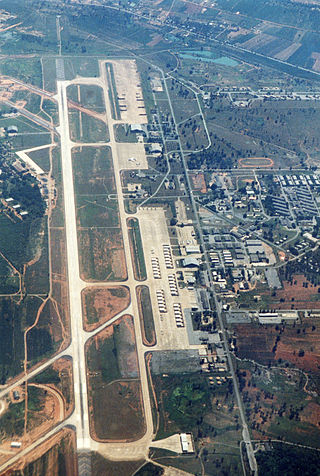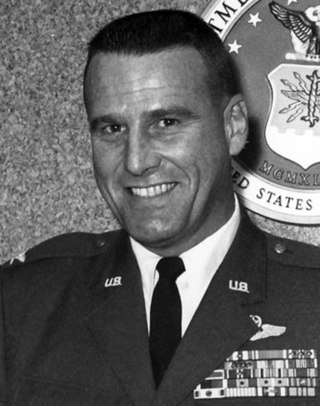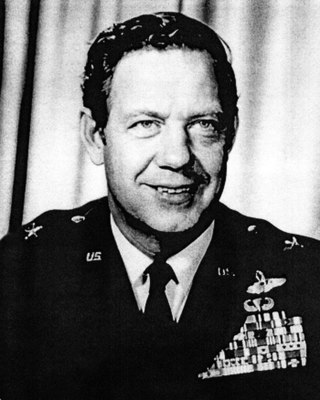
Joseph William Kittinger II was an officer in the United States Air Force (USAF) who served from 1950 to 1978, and earned Command Pilot status before retiring with the rank of colonel. He held the world record for the highest skydive—102,800 feet (31.3 km)—from 1960 until 2012.

Francis Richard "Dick" Scobee was an American pilot, engineer, and astronaut. He was killed while commanding the Space Shuttle Challenger in 1986, which suffered catastrophic booster failure during launch of the STS-51-L mission.

The Distinguished Flying Cross (DFC) is a military decoration of the United States Armed Forces. The medal was established on July 2, 1926, and is currently awarded to any persons who, after April 6, 1917, distinguish themselves by single acts of heroism or extraordinary achievement while participating in aerial flight. Both heroism and extraordinary achievement are entirely distinctive, involving operations that are not routine. The medal may be awarded to friendly foreign military members in ranks equivalent to the U.S. paygrade of O-6 and below in combat in support operations.

The Republic F-105 Thunderchief is an American fighter-bomber that served with the United States Air Force from 1958 to 1984. Capable of Mach 2, it conducted the majority of strike bombing missions during the early years of the Vietnam War; it is the only American aircraft to have been removed from combat due to high loss rates. It was originally designed as a single-seat, nuclear-attack aircraft; a two-seat Wild Weasel version was later developed for the specialized Suppression of Enemy Air Defenses (SEAD) role against surface-to-air missile sites. The F-105 was commonly known as the "Thud" by its crews.

McConnell Air Force Base is a United States Air Force base located four miles (6 km) southeast of the central business district of Wichita, a city in Sedgwick County, Kansas, United States. The airbase was named in honor of the brothers Fred and Thomas McConnell of Wichita, who had both been Air Force pilots and veterans of World War II. It is the home of Air Mobility Command's 22nd Air Refueling Wing, Air Force Reserve Command's 931st Air Refueling Wing, and the Kansas Air National Guard's 184th Wing.

Brigadier General James Robinson "Robbie" Risner was a fighter pilot in the United States Air Force, and a senior leader among U.S. prisoners of war during the Vietnam War.

Leo Keith Thorsness was a colonel in the United States Air Force who received the Medal of Honor for his actions in the Vietnam War. He was awarded the medal for an air engagement on April 19, 1967. He was shot down two weeks later and spent almost six years in captivity in North Vietnam as a prisoner of war. After his military service, Thorsness served one term in the Washington State Senate.

James "Jabby" Jabara was the first American and United States Air Force jet ace. Born in Oklahoma, he lived in Kansas where he enlisted as an aviation cadet at Fort Riley after graduating from high school. Jabara attended four flying schools in Texas before he received his pilot's wings and was commissioned as a second lieutenant. Jabara flew two tours of combat duty in Europe during World War II as a North American P-51 Mustang pilot, and scored 1.5 air victories against German aircraft.

Korat Royal Thai Air Force Base is a base of the Royal Thai Air Force (RTAF) in northeast Thailand, approximately 200 km (125 mi) northeast of Bangkok and about 4 km (2.5 mi) south of the centre of the city of Nakhon Ratchasima in the Nakhon Ratchasima Province, the largest province in Thailand.
Nguyễn Văn Cốc is a former North Vietnamese MiG-21 fighter ace of the Vietnamese People's Air Force's 921st Fighter Regiment.

Takhli Royal Thai Air Force Base is a Royal Thai Air Force (RTAF) facility in central Thailand, approximately 144 miles (240 km) northwest of Bangkok in Takhli District, Nakhon Sawan Province.
Nguyễn Hồng Nhị was a Vietnamese MiG-21 fighter ace in the Vietnam People's Air Force's 921st Fighter Regiment.

Patrick K. Gamble is a retired president of the University of Alaska and a retired United States Air Force (USAF) general whose assignments included service as Commander, Pacific Air Forces, Hickam Air Force Base, Hawaii.
Nguyễn Nhật Chiêu was a Mikoyan-Gurevich MiG-21 pilot of the Vietnamese People's Air Force (VPAF); he flew with the 921st Fighter Regiment first with the MiG-17 before transitioning into the MiG-21, and is tied for fourth place amongst Vietnam War fighter aces with six kills.

Jacksel Markham "Jack" Broughton was a career officer and fighter pilot in the United States Air Force (USAF). He retired in the rank of colonel on August 31, 1968, with 43 separate awards and decorations, including four Distinguished Flying Crosses, two Silver Stars and the highest Air Force service decoration for heroism, the presidentially-awarded Air Force Cross. Broughton avowed that his proudest accomplishment was being combat-qualified in every air force fighter from the P-47 Thunderbolt to the F-106 Delta Dart. He authored two personal memoirs of the Vietnam War that were highly critical of the direction of the air war there and the rules of engagement.

Robert M. Bond was a lieutenant general in the United States Air Force (USAF). He saw combat in Korea and three tours in Vietnam, before becoming an instructor and then vice-commander of an organization which developed and evaluated weaponry for the USAF. He was decorated for his combat service and his peacetime role. He died in an accident in Nevada while flying a Soviet-built Mikoyan-Gurevich MiG-23 jet fighter-bomber.

Paul Page Douglas Jr was a brigadier general in the United States Air Force. During World War II, he flew the P-47 Thunderbolt in the European Theater of Operations and became one of the most highly decorated flying aces of the war. In 1968, he served as the commander of the 388th Tactical Fighter Wing and flew a full tour of bombing and fighter missions over North Vietnam. He retired from the Air Force on 1970.

Henry "Hank" Buttelmann was a fighter pilot of the United States Air Force in the Korean War and Vietnam War. He achieved seven victories over enemy aircraft in Korea, making him a flying ace. He gained his fifth kill on June 30, 1953, just after his 24th birthday, which made him the youngest ace of the war.

The 12th Flying Training Wing is a United States Air Force unit assigned to Air Education and Training Command's Nineteenth Air Force. It is headquartered at Joint Base San Antonio, Texas. The wing is the parent organization for the 479th Flying Training Group, located at NAS Pensacola, Florida and the 306th Flying Training Group, at The United States Air Force Academy, Colorado. The 12th Wing is the only unit in the Air Force conducting both pilot instructor training and combat systems officer training.

Robert Farren Titus was a brigadier general and a career fighter pilot in the United States Air Force. Titus flew a combined total of 500 combat missions in Korean War and Vietnam War, and was credited in destroying 3 enemy aircraft in aerial combat during the Vietnam War. Titus retired in 1977, after 32 years of distinguished service.

















